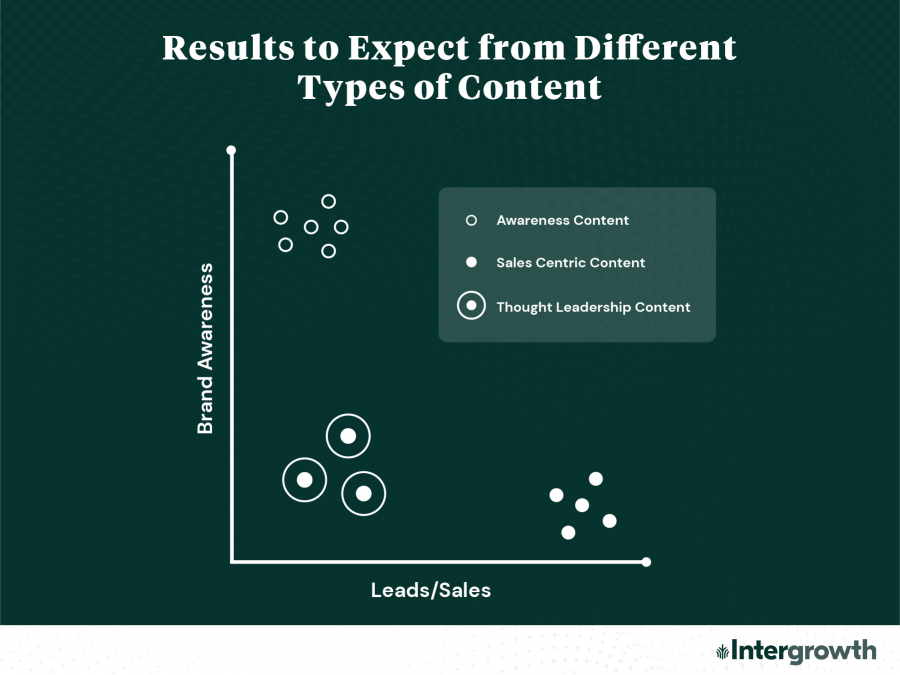Dual Purpose Content breaks the rules.
It’s any content that achieves multiple goals that are typically at odds with each other.
We’ve written in the past about the four components of a successful content strategy.
Today, we’re sharing our secrets to driving even better results within those three content formats through Dual Purpose Content.
But first, let’s recap the goals of content marketing.
The Goals of Content Marketing
Successful content marketing focuses on achieving one of three business goals:
- Drive revenue or help maintain existing revenue
- Drive visibility for the brand (typically measured in terms of traffic or impressions)
- Increased perception of your brand as an “expert” in your industry
Each goal requires a different approach within the content creation process.
Whether a blog article, YouTube video, or Twitter thread, deliberate focus on one of these three goals brings the greatest likelihood of achieving that particular business objective.
1. Drive Revenue Through Sales Centric Content
With this approach, the goal is to create content that will drive more revenue for your business when shared with the right people at the right time.
We group this type of content into two parts:
- Revenue Creators
- Revenue Preservers
Revenue Creators will turn website visitors into leads or customers. This type of content includes:
- Case studies
- Detailed breakdowns of features of your product/service
- Customer review
- And more
These resources help convince prospects to spend money working with you, rather than a competitor.
Revenue Preservers serve as customer support resources. They focus on making life better for existing customers to keep them as paying customers longer.
Support forums are the perfect example of this.
They provide detailed walkthroughs intended to show existing customers how to use your product, how to update account settings, and more. They also offer a secondary benefit of helping cut down on the time your customer service team needs to spend walking existing customers through common questions daily.
With most businesses, customers don’t actively seek out answers to sales-centric questions on Google.
Most sales questions will be discussed over the phone/email with a sales rep, by seeking out feedback from past/current customers (through personal networks or reading online reviews), weighing pros and cons of features and pricing with competing products/services, or by coming across sales-centric resources via email workflows or through internal links in other articles that the read on the business’s website.
Sales Centric Content will drive minimal brand awareness but will be some of the highest-converting pages on your site.
The exception here is SaaS businesses, but more on that below.
2. Drive Visibility for the Brand Through Awareness Content
Awareness Content focuses on introducing your business to potential customers by ranking at the top of search engines for high search volume queries.
The process starts with a content marketing strategist identifying high-volume keywords and writing a high-quality guide that targets those keywords (or finding existing content pieces on their website that relate to those keywords). The content strategist then optimizes the relevant content around those keywords and publishes the content.
Ranking at the top of search results for each query could introduce your business to hundreds, if not thousands, of people searching for information about your industry every month.
When successful, Awareness Content helps you become “first to mind” when people think about your industry.
For example, we wrote this article in 2019 about partnership marketing for Streamline. Today, this article ranks on the first page of Google for dozens of keywords about partnership marketing.
Is the average reader of this article ready to start working with Streamline today?
Definitely not.
However, Streamline now owns the definition of “partnership marketing” for those new to the concept three years later. Streamline will likely become the first to mind when many individuals think of the term.
3. Increased Perception of your Brand’s Expertise Through Thought Leadership Content
Thought Leadership Content focuses on attracting the whales of your industry.
Here, the objective is to create a resource that:
- Thought leaders in your industry find and read (typically through being shared in an industry publication or social media).
- Thought leaders find insightful enough to perceive your company as experts in this subject matter.
- Thought leaders share it with their followers, who also start to perceive your company as experts in this subject matter.
With Thought Leadership Content, brand awareness and lead flow will be minimal.
With most businesses, high-search volume themes will be broader topics that industry experts aren’t regularly searching for.
For example, writing articles like “what is [industry term].”
These types of articles won’t increase your perceived expertise amongst those informed about your industry.
Most of the thought leadership concepts that your business could write about will fall into the category of “unknown unknowns.” Many of the expert insights you share about your industry will be about topics people don’t know that they don’t know about.
If the people who will most benefit from reading these articles don’t know that these topics exist, they likely need to encounter them from a channel other than organic search results.
Some examples of Thought Leadership Content include predictions of where your industry is going (here’s one example from an October 2022 interview), unique approaches to a particular process (here’s an explanation of how we conduct keyword research differently than the typical SEO), and more.

How to Strategically Allocate Resources to Each Type of Content
One of the greatest challenges in content marketing is defining how much to invest in each type of content.
- Awareness Content drives excellent visibility but drives minimal revenue. Most of the revenue it brings comes indirectly by funneling visitors to more valuable pages on the site.
- Sales Centric Content has high conversion rates but brings few people to your website.
- Thought Leadership Content brings perceived expertise amongst others in your industry. Still, even the best thought leadership content requires some degree of luck to succeed (and likely won’t drive meaningful traffic or sales).
…But what if we didn’t have to choose between these outcomes?
Welcome to the Dual Purpose Content Framework
How to Create Dual Purpose Content
To create Dual Purpose Content, start with identifying the primary goal of the piece of content that you’re working on. Ensure everything you do aligns with that goal.
The goal of Awareness Content is to drive visibility to your brand.
In our experience, the best way to consistently achieve this goal is to get that piece of content to rank at the top of search results for dozens of keywords related to a broad search theme.
We achieve this by keeping the following elements in mind during the creation process:
- Use strategic keyword research to find realistic ranking goals that will snowball into more impressive rankings over time.
- Write an in-depth guide on the subject matter. The average first-page result on Google is 1,447 words. We recommend writing at least this length.
- Ask whether your resource helps searchers to achieve the goal associated with their search query.
The goal of Sales Centric Content is to drive more revenue for your business.
In our experience, the best way to achieve this goal is to create content with the following elements:
- Succinct arguments of why working with your business is the best option for a specific type of customer.
- Showcase the benefits of working with your company over a competitor (ex. articles comparing yourself to a competitor).
- Attach proof of other happy customers, either through showcasing customer feedback or results achieved from past customers (ex. case studies).
The goal of Thought Leadership Content is to be perceived as an expert by others in your industry.
In our experience, the best way to achieve this goal is to create content about new ideas or unique perspectives.
For example:
- Your stance on why [insert commonly-held industry belief] is wrong
- Presenting a new way of solving a common problem in your industry
- Potential future problems that others in your industry aren’t thinking about
From there, look to achieve any secondary or tertiary goals, so long as they don’t interfere with goal #1.
For example, Sales Centric Content typically performs best when more succinct.
But why not test out the Awareness Content approach with a sales-centric content idea that sees high search volume?
Below, we’ll share more context on the content marketing frameworks that we’ve found effective in creating Dual Purpose Content.
Dual Purpose Content: Awareness and Sales Content
Identify a concept with high commercial intent, find a relevant keyword theme to target, and write an in-depth guide that has everything needed to rank at the top of search results.
This page will likely see lower conversion rates than a short-form sales argument. However, if it drives 10x more traffic to the site, the increased traffic will more than compensate for the lower conversion rate in terms of sales that it generates.
- Write articles about “best [product/software category]” that compare your business to your competitors. For example, “best night guards.”
- Write articles about “[competitor] alternatives” that position you as a better option than your competitor for individuals with specific use cases or pain points. For example, “calendly alternatives.”
- Write an article about “[solution] services” that highlights everything your customers should look into when paying for a solution, while also qualifying when your business is the right solution for them. For example, “construction services.”
- Write articles about “best [product/software category] for [customer demographic]” to compare your software to competitors and highlight why you’re a better solution for a specific customer demographic. For example, “best CRM for independent contractors.”
- Write articles about “buy [product]” that features advice on how to vet and find the right product for you. For example, “buy shoes.”
- Write an article about “[product/service] benefits” that features a series of benefits that your target audience will get from investing in that solution. For example, “digital marketing benefits” or “french press benefits.”
Dual Purpose Content: Thought Leadership and Awareness Content
Identify a concept that you can share a unique perspective on.
Map out your argument for that perspective, and then go to keyword research to see if there are any high search volume + low keyword difficulty search themes that you can align with your concept.
After defining a thought leadership topic, my favorite starting point is conducting Reverse Engineered Keyword Research to build a list of potential keyword themes.
Write an article about “[industry] trends for [year]” that highlights yours/your team’s predictions for the biggest changes that you expect to see in your industry in the coming year (best released early in the year to maximize content lifespan).
The key to success here is going beyond the obvious statements and offering a handful of bold predictions that will draw some disagreement from others in your industry.
There’s nothing bold about writing an article targeting “travel trends for 2022” that says travel will rise above 2020 levels. However, making a strong case for a 50% increase in digital nomads in 2022? Now we’re talking!
Write an article about “[industry concept] process” that breaks down your team’s unique, step-by-step process for completing a particular task on a daily basis.
Note: this works best for industries that have greater degrees of differentiation. Papa John’s might be able to write about how their pizza-making process is different from Pizza Hut, but that isn’t likely to impress others in their industry.
On the other hand, a sales consultant sharing her unique process for turning a lead into a customer through email automation could be perfect.
Brand a new concept for a unique approach that your team takes.
Inventing new terminology based on a proven process that your team uses is a powerful way to position yourself as unique from the competition and be recognized as a thought leader in your industry.
Search volume should be non-existent starting out. However, if you can build awareness around the concept, you can cement your ownership of that concept in search results.
A Few Examples of Successful Dual Purpose Content that We’ve Created
Physician Thrive’s Contract Review Pillar that Became a Lead Magnet
We first published The Definitive Guide to Physician Contract Review in late 2019. The intent was to create Awareness Content in the form of a pillar page for all contract review content on their site.
We designed the page to give physicians a brief overview of every subject related to negotiating for better terms in their employment contracts, with the goal that we would then link out to more in-depth resources related to each individual subject.
As we were finalizing the draft, we then looked deeper to see how we could inject more conversion elements to maximize the number of leads that Physicians Thrive sees from this article every month.
Three years later, this page serves as a successful pillar for the contract review side of their business, helping to generate massive amounts of organic traffic every month. The page has also become a lead magnet. It serves as one of the highest lead generators on the site today.
To date, we’ve helped Physicians Thrive see a 790% increase in leads. Read the full story here.
Interweb’s Thought Leadership Process Drives Massive Brand Recognition
We wrote an in-depth guide about our domain migration process that offers an in-depth breakdown of the SEO steps that we use when working with teams changing their website domain without losing all of their search engine traffic.
We wrote the article to drive thought leadership, and from there, ran Reverse Engineered Keyword Research to see how we could position the article to target relevant search volume queries.
Bloom’s Sales Article that Became a Top Traffic Driver
We wrote The Best Apps for Independent Contractors back in 2020 to be a sales-centric piece of content.
Bloom’s primary customers were independent contractors and small business owners. We wrote this article with the intent that we would funnel people to the site from our top-of-the-funnel articles and drive more account signups.
Three months later, it was one of the top organic traffic drivers on their site while also driving significant account signups.
We wrote this article with a sales-centric mentality. Once we had mapped out how to create a top-performing sales article, we went back to the keyword research process to see how we could fit relevant keyword targets into the article without jeopardizing lead flow.
Note: Dual Purpose Content that focuses on awareness and sales often works well for SaaS businesses.
SaaS businesses will often see higher keyword competition around themes like “[competitor] alternatives,” “[use case] software,” and “[competitor #1] vs. [competitor #2].” However, these themes often see massive search volumes for keywords with high buyer intent.
Related: read our step-by-step guide to SEO for software as a service businesses
Our Marketing Strategy Insights Become a Primary Awareness Driver
Every year, a few dozen clients and sales prospects ask for our advice on how to build their annual marketing strategy for their business.
I love getting this question. There’s a different answer for every business that we talk to.
We wrote Building a Strategic Marketing Plan as a thought leadership piece of content, designed to help other businesses to answer this question for themselves.
- We broke down the typical questions that we ask during these conversations.
- We offered guidance on how to run a quick and dirty audit of the previous year’s marketing performance.
- We offered broad suggestions that they could act upon based on their findings from #1 and #2.
As we wrapped up the first draft of the article, we approached keyword research as an afterthought.
“Marketing strategy” and “Marketing audit” keywords had low search volumes and were difficult to rank for. Despite that, this article has dominated as Awareness Content for our brand. It was the 7th highest organic traffic driver to our site in the second half of 2021.
Applying this Content Framework to Your Business
Most great content succeeds by focusing on one specific goal. However, why not look beyond that goal to see how you can take your content to the next level?
- Identify the core success metrics for your business for each content framework. For example, Sales Centric Content KPIs might include lead form submissions, email subscribers, and goal conversion rate.
- Run a content audit to understand the existing content that is performing well that can be expanded for better results.
- Use the content strategy frameworks above to build a list of new topics to add to your editorial calendar.
- Review performance and repeat.
Have questions or thoughts on Dual Purpose Content?
Share them with us on Twitter — we’d love to hear from you.
SCALE YOUR ORGANIC TRAFFIC
Subscribe to our monthly newsletter



